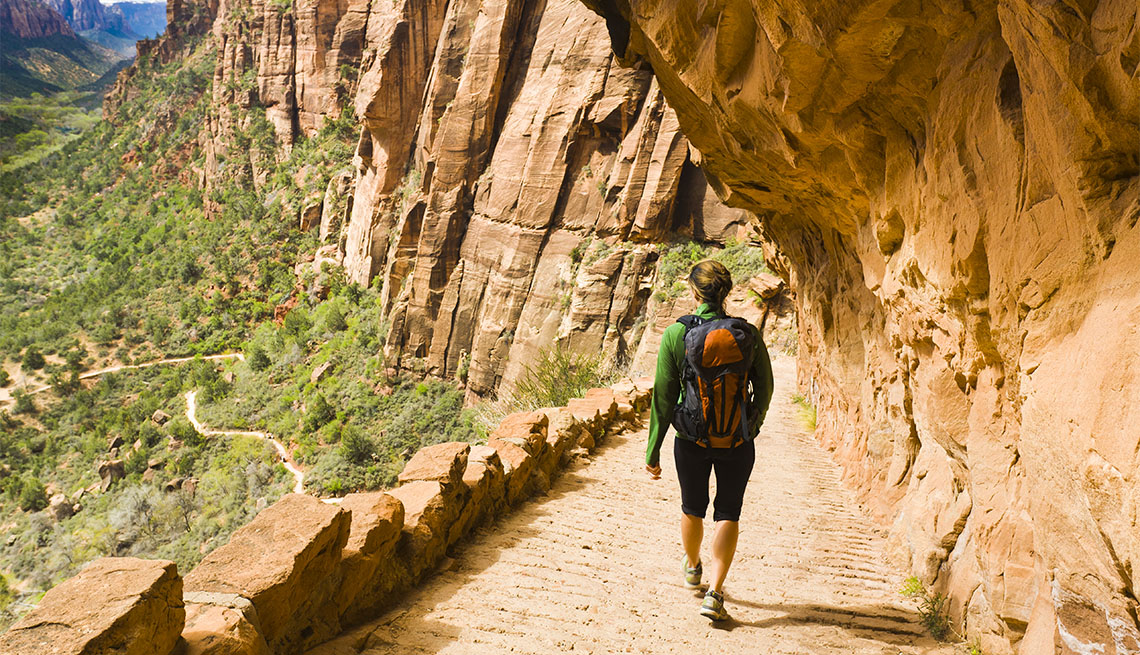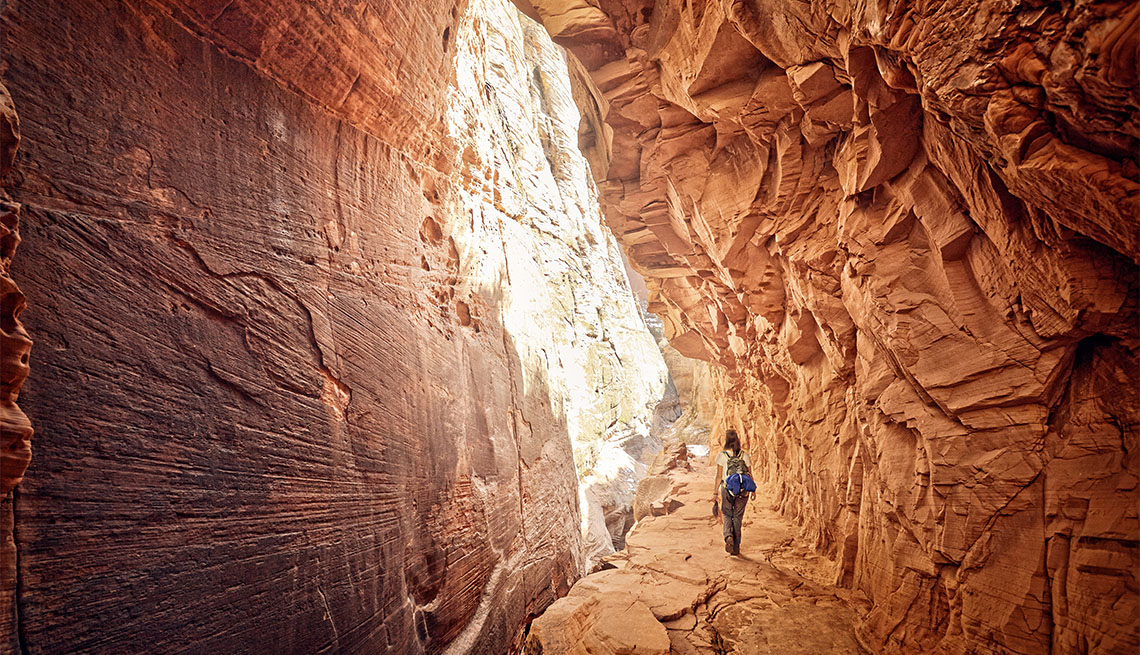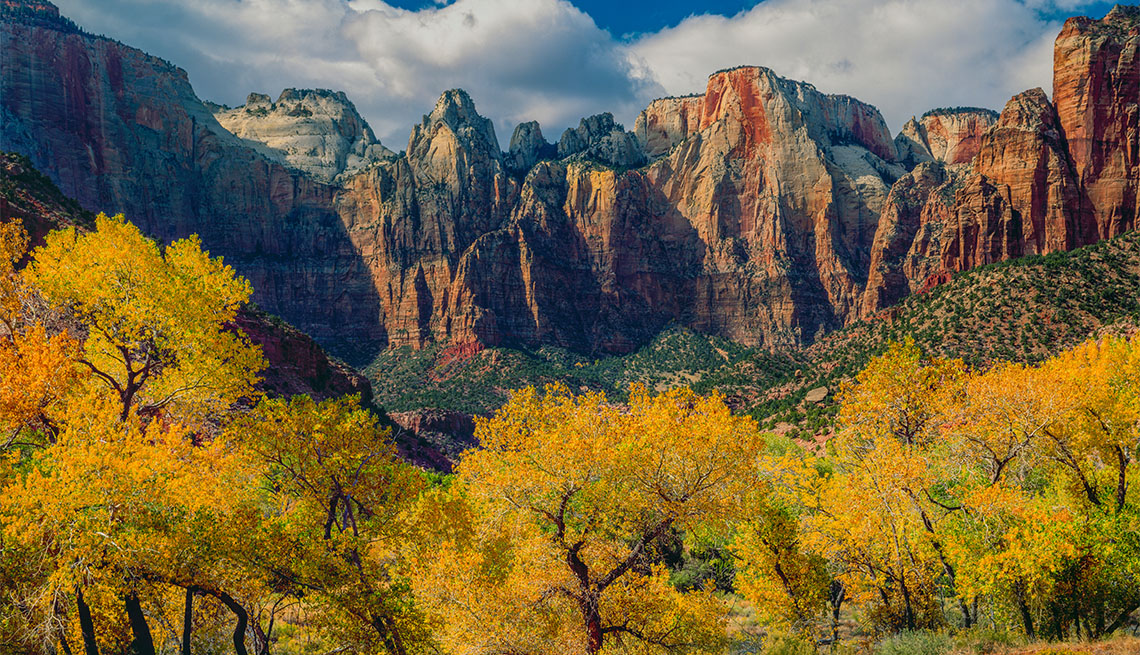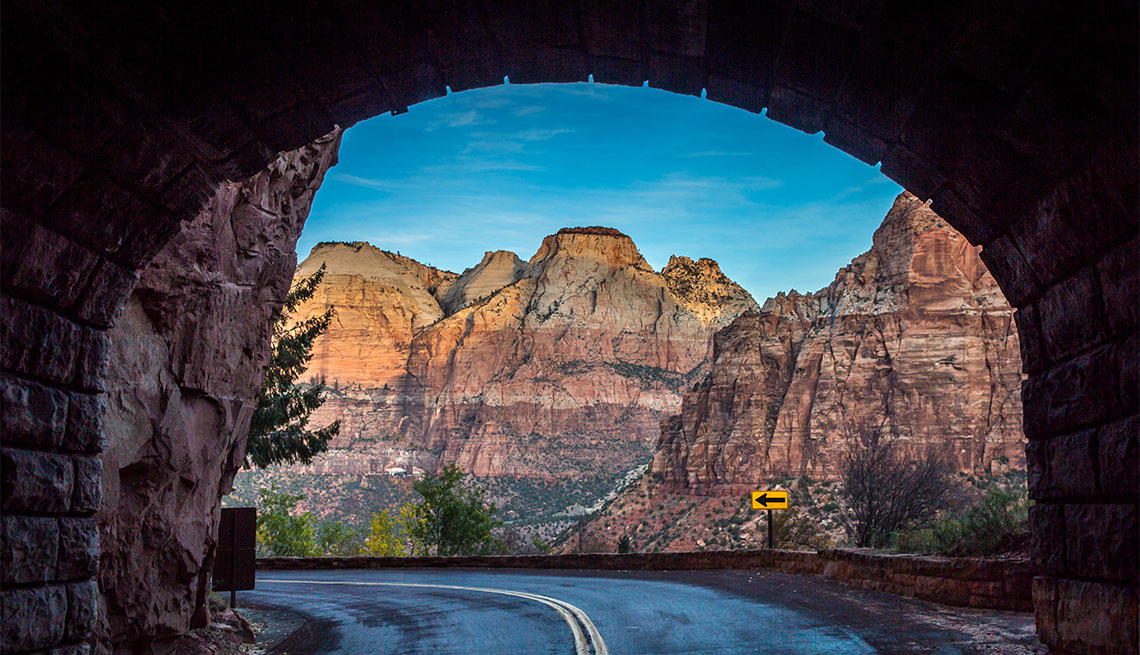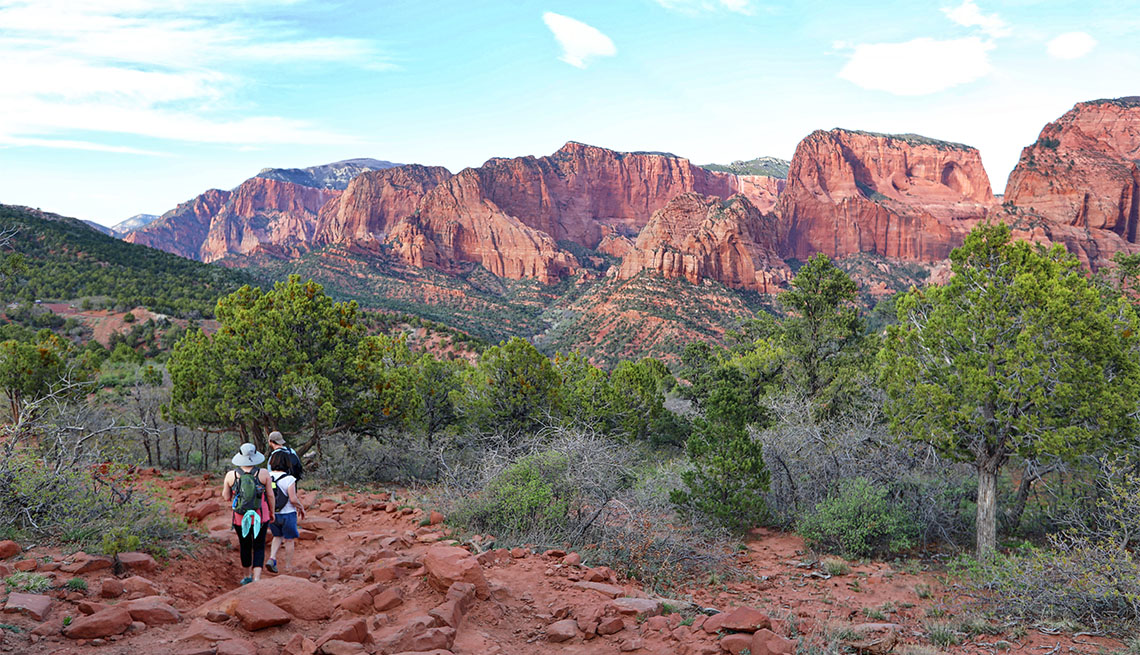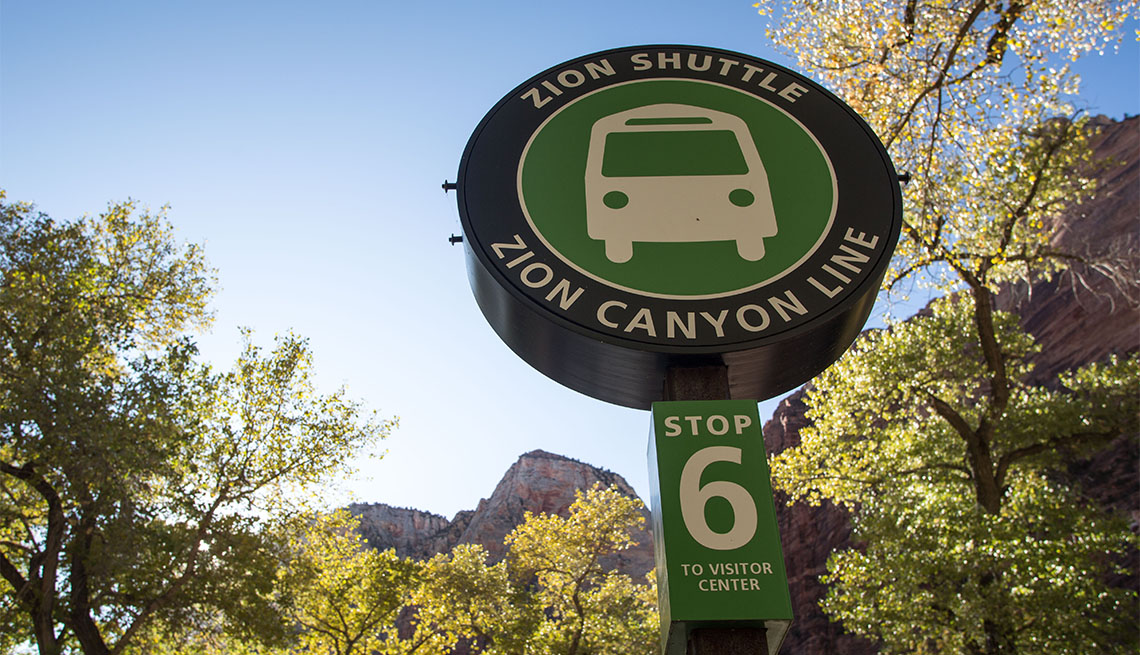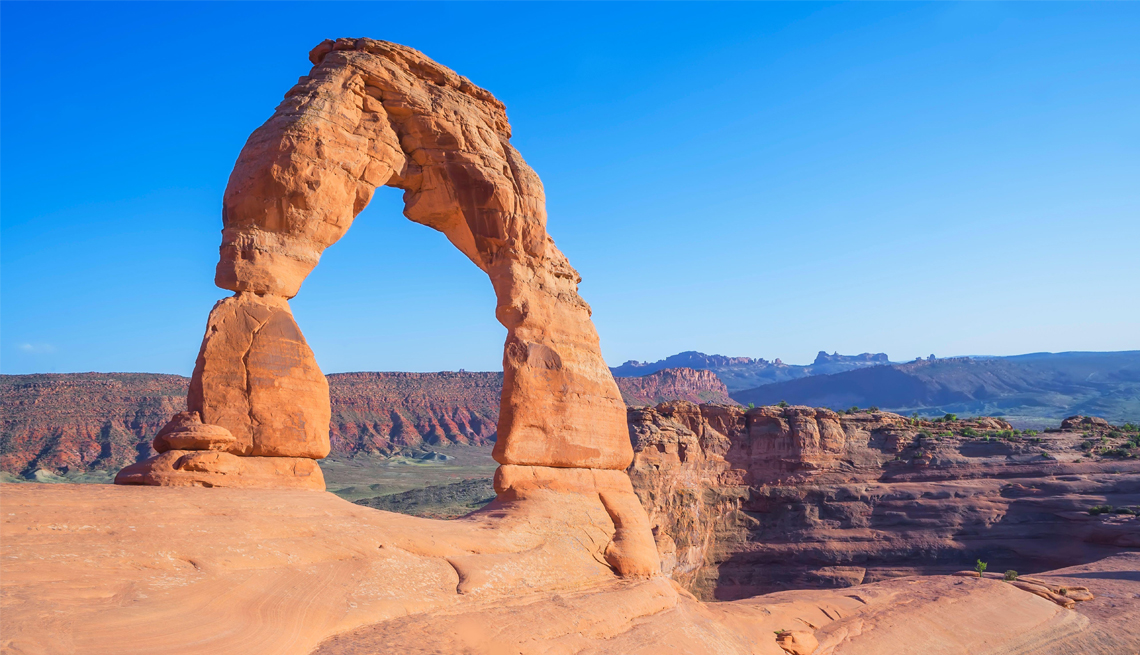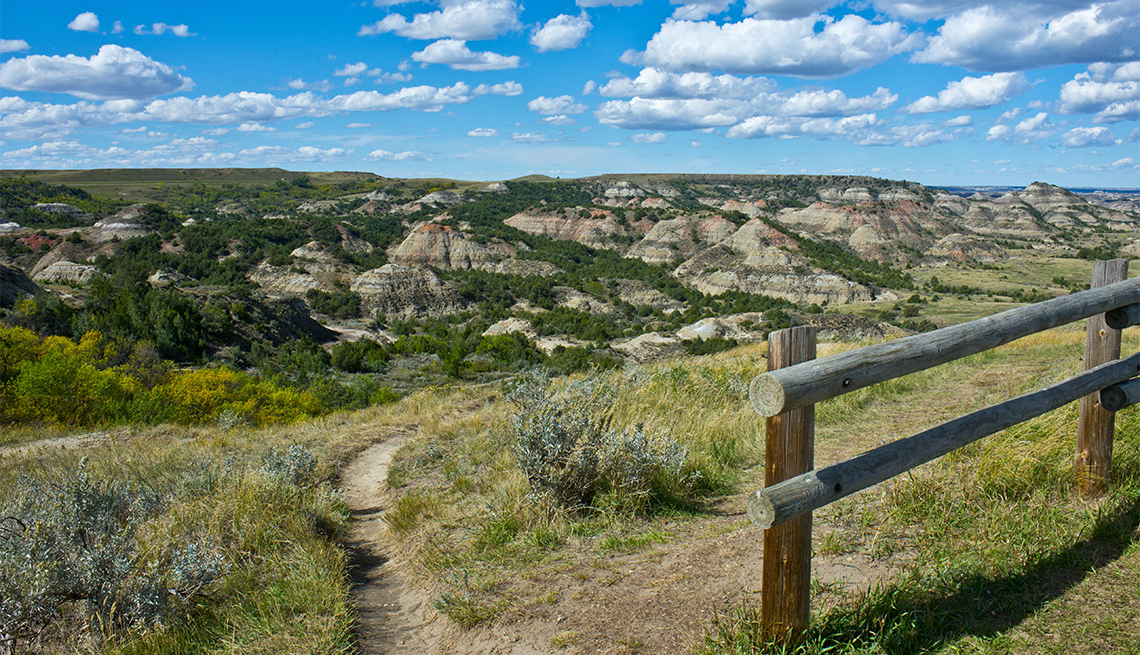AARP's Guide to Zion National Park
Cathedral-like canyons and majestic sandstone cliffs create a wondrous landscape
Don't be surprised if your first glimpse of Zion National Park (ZNP), with its vast red rock canyons and towering sandstone temples, feels a bit like a spiritual awakening. You wouldn't be the first person moved by its majesty.
The Southern Paiute called it Mukuntuweap, meaning “straight-up land.” They found sanctuary and sustenance within the sheer walls of Zion Canyon, harvesting plants and seeds for food and medicine and cultivating corn, squash and sunflowers near the Virgin River. When Mormon settler Isaac Behunin built a cabin on the canyon floor in 1863, he was inspired to proclaim, “A man can worship God among these great cathedrals as well as in any man-made church — this is Zion."
ZNP's more than 148,000 acres sit at the junction of the Colorado Plateau, the Great Basin and the Mojave Desert in Utah's southwest corner. The fusion of these distinct geographical regions created the park's wondrous landscape, which comprises six unofficial sections: the Main (Zion) Canyon, Desert Lowlands, Kolob Canyons, Kolob Terrace, Upper East Canyon and Zion Narrows.
These ecosystems nurture verdant hanging gardens spilling with maidenhair ferns and high-country forests teeming with aspens and ponderosa pines. They provide refuge for abundant wildlife, from tiny endemic Zion snails to bighorn sheep, desert tortoises and the critically endangered California condors. But despite the richness of its flora and fauna, the real star of Zion's show is the scenery — Navajo sandstone cliffs, soaring rock spires and a spectacular gorge carved over millennia by the Virgin River's powerful surge.
Today Zion attracts 4.5 million visitors annually — from the most adventurous rock climbers to laid-back sightseers looking to enjoy an easy hike — and continues to evoke a profound sense of awe in all those who witness its splendor.
Location: Utah's southwest corner
Acreage: More than 148,000 acres
Highest peak: Horse Ranch Mountain, 8,726 feet
Lowest point: Coalpits Wash, 3,666 feet
Miles of trails: More than 90 miles along more than 35 trails
Main attraction: Zion Canyon
Entry fee: $35 per vehicle, valid for seven consecutive days. $20 for an annual Senior Pass (62+).
Best way to see it: The Zion Canyon Shuttle (from mid-March through November), which makes nine stops on the Zion Canyon Scenic Drive
When to go to avoid the crowds: Late September through November
Plan Your Trip
St. George Regional Airport offers the easiest access to Zion National Park. From there it's only 45 miles northeast to the charming gateway town of Springdale and Zion's main entrance. But most people fly into McCarran International Airport in Las Vegas — a larger hub with direct flights from multiple U.S. cities — and drive 165 miles northeast through vast swaths of the Mojave Desert to Springdale.
ZNP is open year-round and each season frames a unique view of the park's beauty. Only a fraction of visitors come between December through February, when daytime temperatures hover around 50 degrees and dip below freezing at night. Quiet trails and scenes of fiery vermilion sandstone dusted with snow reward those who brave the chill. March and April deliver temperatures ranging from 35 to 70 degrees and an influx of spring-break travelers as snowmelt feeds waterfalls and wildflowers. The mercury begins to rise in May and by mid-June daytime temperatures climb into the triple digits, where they linger until September. Fortunately, they drop to 60 to 70 degrees late in the evening. An early-morning start, frequent water breaks and seeking out shady trails are the keys to summer in the park.
For the perfect mix of comfortable weather, with temperatures ranging from 70 degrees during the day to 40 at night, fewer crowds and affordable lodging options, late September through November is ideal. Though the days are shorter, trails and services should be fully operational and the cottonwoods will be decked out in autumn's golden glory.
The park's visitor centers, shuttles, museum, restrooms, buses, picnic areas and Zion Lodge are all fully accessible, and several campsites in the Watchman Campgroumd are reserved for those with disabilities. Additionally, all shuttle stops have benches and many trails have flat rocks perfect for resting a spell. Rocking chairs on Zion Lodge's porch offer a lovely place to while away an hour in the shade.
The bulk of the park's action happens in Zion Canyon, which visitors can access only via free park shuttles from March to November and during peak holiday periods. These shuttles make nine stops at major trailheads and points of interest along Zion Canyon Scenic Drive. Visitors are only allowed to drive on that road and access the canyon in their cars during those times of the year the shuttles aren't running. When they're operating, park at the main entrance and board a bus at the Zion Canyon Visitor Center, but be aware that lots fill early, especially during the busy summer months. A second shuttle stops at multiple points along Zion Park Boulevard in Springdale, making it easy to leave your car at your hotel or in the town's paid parking areas and avoid the hullabaloo at the main entrance.
Though most visitors never venture beyond Zion Canyon, you can easily escape the masses in other park sections. You can drive to trailheads and viewpoints in seldom-explored areas along the Zion–Mount Carmel Highway (which links Zion Canyon Scenic Drive to the park's East Entrance) and in Kolob Canyon, about 45 miles north of Zion Canyon.
Where to Stay and Eat
Built in 1925 and restored to its original stone-and-timber charm in 1990, the Craftsman-style Zion Lodge, the only in-park hotel, sits right in the heart of Zion Canyon. Set against a majestic red rock backdrop, its 81 rooms and 40 cabins sprawl across a verdant expanse of lawn shaded by a 100-year-old Fremont cottonwood tree. Request a room or cabin with a porch overlooking the lawn and surrounding cliffs.
Dine on upscale fare with desert flair at the lodge's Red Rock Grill — and sit out on the outdoor terrace for gorgeous canyon views. Two menu standouts: chili tacos made with Navajo fry bread and a locally sourced bison burger topped with cheddar cheese and jalapeños. Open seasonally, the Castle Dome Café, which serves snack-bar favorites such as hot dogs and ice cream on a shady patio, makes for a good pit stop if you have wilting grandchildren in tow.
For a heftier dose of the great outdoors, put down roots at one of two campgrounds for campers, RVs, tents, trailers and vans near the Zion Canyon Visitor Center. The South Campground (open March–November) has 117 sites (three accessible) encircled by towering cliffs between the Virgin River and the popular Pa'Rus Trail. Tucked at the foot of Zion's iconic Watchman rock formation, the eponymous Watchman Campground (open year-round) offers 197 sites (seven accessible, plus additional flat sites with easy access). Both campgrounds have restrooms, but only Watchman has some sites with electricity. Just outside the park entrance, at Zion Outfitter in Zion Canyon Village, you'll find token-operated showers and laundry facilities. Campsite reservations, which are highly recommended, can be made for the South Campground two weeks in advance; for Watchman, up to six months in advance. Permits cost $20 to $130 nightly.
Backcountry camping is available May through September at the first-come-first-served Lava Point Campground off Kolob Terrace Road, about an 80-minute drive south from the park's main entrance. It has just six (free) primitive campsites, with pit toilets but no water.
Things to Do
In the Zion Canyon Section
Inarguably, ZNP's main attraction is Zion Canyon. Fifteen miles long and nearly 3,000 feet deep in some spots, the canyon wows visitors with some of the park's most dramatic scenery, including the Court of the Patriarchs, the Great White Throne and the Towers of the Virgin. Walking among these sandstone monoliths, with their massive, multilayered peaks streaked with iron oxide, feels like being in a giant's sculpture garden.
Get oriented at the Zion Canyon Visitor Center, where you'll find trail maps, helpful rangers and the canyon shuttle. The shuttle ride and accompanying recorded narration is a relaxing way to experience Zion Canyon's highlight reel. It takes about 40 minutes to travel the 6.6 miles from the visitor center to the last stop at the Temple of Sinawava, a soaring stone amphitheater named for the coyote god of the Paiute people. Hop on or off at any of the shuttle stops along Zion Canyon Scenic Drive.
At the second stop, don't miss the new film “We the Keepers,” created by the not-for-profit Zion Forever Project. The 23-minute film plays throughout the day at the Human History Museum, providing a moving overview of the park and its stewards. Museum exhibits showcase the natural and cultural phenomena that helped make Zion what it is today. On the patio, park rangers give talks on everything from survival tactics of the park wildlife to Zion's fascinating geology.
Visitors best experience ZNP's beauty by trekking any of its 35-plus trails totaling more than 90 miles, and in Zion Canyon, those with mobility issues or those looking to go on an easy bike ride should set out on the Pa'Rus Trail. Named for the Paiute word meaning “bubbling, tumbling water,” the trail starts just north of the Zion Canyon Visitor Center at the South Campground and follows a paved, 1.7-mile path through beautiful open canyon. Another easy, magical hike in the canyon, the 1.1-mile Riverside Walk (the first 0.4 miles fully accessible), begins at the final shuttle stop and traces the edge of the Virgin River. Along the way, lush foliage spills from weeping canyon walls and cathedrals of rock envelop you on all sides.
The trail ends at the entrance to the Narrows hike, which leads into the legendary slot canyon that marks Zion Canyon's narrowest section: About two miles into the gorge the sheer, 1,000-foot canyon walls flanking the Virgin River close in, leaving just 20 feet between them. If you're an adventure-seeker planning to hike the Narrows, come prepared with closed-toed, waterproof hiking boots — you'll be wading through the river much of the time — and a walking stick to help navigate the slippery riverbed. Some people liken it to walking on wet bowling balls. Don't dismay if you decide to turn back early: Even a short foray into the canyon delivers a memorable experience.
You might also like saddling up and exploring the canyon on horseback, a fun way to cover more ground than you might on foot. At the corral for Canyon Trail Rides, across the road from Zion Lodge, join a one-hour excursion along the Virgin River to the Court of the Patriarchs, three towering terracotta-hued peaks named for the biblical figures Abraham, Isaac and Jacob.
In Other Park Sections
Some of the park's other areas offer unsung hiking paths and gorgeous overlooks minus the canyon's crowds, and plenty are accessible by car.
One excellent option: a drive along the Zion–Mount Carmel Highway, a 10-mile stretch of twisting switchbacks and stunning vistas that links the Main Canyon to the park's eastern boundary. Kick things off with a stop at the Canyon Junction Bridge — the view over the Virgin River, with the giant rock buttress Watchman in the distance, is particularly spectacular at sunset. In about 31/2 miles, you'll reach the Zion–Mount Carmel Tunnel, where six huge windows cut into its sandstone walls deliver a fleeting glimpse of the canyon below.
For another splendid drive, take the road even less traveled and head 45 miles north of Springdale to the park's Kolob Canyons section, a vast maze of towering crimson “finger” canyons replete with solitude and breathtaking wilderness. The Kolob Canyons Viewpoint, a 10-minute drive from the Kolob Canyons Visitor Center, makes a perfect picnic spot. From there, a gentle jaunt on the half-mile-long Timber Creek Overlook Trail leads along the ridgeline and boasts scenery that rivals anything you'll see in Zion Canyon.
AARP Membership -Join AARP for just $15 for your first year when you enroll in automatic renewal
Join today and save 25% off the standard annual rate. Get instant access to discounts, programs, services, and the information you need to benefit every area of your life.
Gateway Towns
With its small-town atmosphere, sweeping canyon views and location just outside the park's South Entrance, Springdale makes an ideal home base for exploring ZNP and offers multiple diversions, including art galleries, when your feet need a break from hiking.
For accommodations, you'll find everything from chain hotels to boutique resorts, cozy inns and vintage motels along Zion Canyon Boulevard, the town's main drag. Cable Mountain Lodge can't be beat for its plushness, spectacular views, gorgeous pool, outdoor firepits and new spa. If you're budget-conscious, you'll appreciate the old-fashioned kitsch at Zion Park Motel, which features newly remodeled rooms with kitchenettes.
For lunch-to-go on your way to the park, pick up gourmet panini from Café Soleil. Later, reward a day of hiking and exploring with a cold craft beer at Zion Brewery, then head to local favorite Oscar's Café for its huge burgers and delicious, Mexican-inspired pub grub. Or wash off the dust and go upscale at King's Landing Bistro. Whet your appetite with a King's Ol’ Fashioned, made using Utah-distilled High West Campfire Whiskey, before tucking into dishes such as rabbit cacciatore over polenta.
En Route
Most Zion visitors fly into Las Vegas and drive to ZNP. For the first 100 miles or so, the highway beelines through barren desert lowlands, passing through a small corner of the rugged swath of land between the Grand Canyon and the Utah border known as the Arizona Strip. About 40 miles outside Vegas, take a short detour to visit Valley of Fire State Park. On the 10-mile Scenic Byway that winds through the park, several easy hikes lead to arches, petroglyphs and pinnacles. Two popular ones: Fire Wave and Rainbow Vista.
Nestled into Utah's southwest corner, the Greater Zion region is a mecca for outdoor enthusiasts and culture seekers alike. Spend some time here before going on to the park, basing yourself in the vibrant hub city of St. George. Check into the family-owned Inn on the Cliff for panoramic views of the red rock landscape, or the Advenire, a luxe new downtown property.
At Sand Hollow State Park in Hurricane, 18 miles northeast of St. George, try stand-up paddleboarding on the reservoir during warm-weather months or head into the dunes on a guided ATV excursion with ATV Adventures year-round.
In Ivins, nine miles northwest of St. George, browse the galleries at the Utah-centric Kayenta Art Village and take in a show at the Tuacahn Center for the Arts, a natural sandstone amphitheater featuring a seasonal lineup of Broadway-caliber performances.
- |
- Photos
Editor's note: This article was originally published on July 31, 2020. It's been updated to reflect recent COVID-19 developments.




